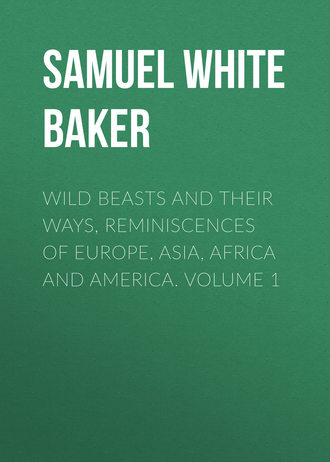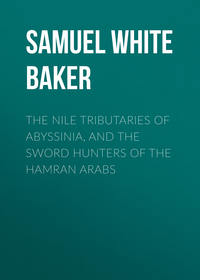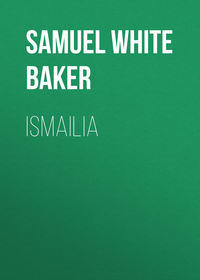 полная версия
полная версияWild Beasts and Their Ways, Reminiscences of Europe, Asia, Africa and America. Volume 1
No lion or tiger can ascend a tree unless the branches spring from within 4 or 5 feet of the ground; even then it would be contrary to the habits of the animal to attempt an ascent, although it might be possible under such favourable circumstances. A leopard will spring up a smooth-barked tree with the agility of a monkey; and there is a small species which almost lives among the branches (F. Macroscelis), from which it leaps upon its prey when passing unconsciously beneath.
An examination of the skins of leopards from various portions of the globe exhibits a striking difference in colouring and quality of fur. We find the snow leopard, which inhabits the Himalayahs and other lofty mountain ranges, with a fur of great value, deep and exceedingly close, while the spots are not determined as distinct black, but are shaded off by gray. This species is generally found at altitudes of from 8000 to 10,000 feet, or even higher. In Manchuria and the Corea there is a species which is unknown in India; this is a large animal, with a peculiarly rich and deep fur when killed during winter; the black spots are exceedingly large, and are formed in rings. A skin in my possession measures 7 ft. 9 in. in length; the tail is full, and the fur long; this is unusually beautiful, and it must have inhabited some lofty altitude where the temperature was generally moderate.
In Africa the leopards have almost invariably solid black spots, very close together upon the back, and becoming less crowded towards the belly and flanks. In Ceylon there are two distinct varieties-the large panther, generally about 7 ft. 6 in. in length, and a smaller leopard, which inhabits the mountains; in that island of misnomers they are both included in the name cheetah.
In India there are several varieties, and the largest is generally distinguished as a panther. There is no animal more commonly distributed in the world than the leopard, and no tropical country is free from this universal pest, unless an island formation has excluded its unwelcome presence.
It is difficult to determine the limit in the gradation of size at which this animal merges from the leopard into the wild cat. The varieties of cats are so numerous that I do not pretend to describe them; some are of sufficient importance to be classed among the smaller leopards, while others are no larger than the ordinary domestic cat. These vary through every shade of feline colouring, from spots to stripes, or to a fulvous brown similar to the tawny coat of a lioness; but, notwithstanding the difference in shades and spots, in cats and in the true leopard or panther the character is the same. They are all cunning, ferocious, and destructive, and I believe that far more cattle and goats are killed by leopards throughout the Indian Empire than by the usually accredited malefactor, the tiger.
The largest and most beautifully marked of the leopards is the jaguar of South America. This is the size of a small tigress, and is more heavily framed than any of the leopards; the head is especially large, and the animal might almost be termed a spotted tiger. The rings are peculiarly marked, and waved instead of being circular.
The cheetah or hunting leopard is a distinct species, and although classed among the leopards, it is altogether different, both in habits and appearance; the claws, although rather long, are not retractile, neither are they curved to the same extent as all others of the genus Felis, but they resemble somewhat the toe-nails of the dog. I shall accordingly separate this animal from the ordinary class of leopards, and give it a separate existence as an object of natural history.
The panther or larger variety of leopard is about 7 ft. 6 in. in length, and has been known to approach closely upon 8 feet, but this would be an unusual size. This animal is exceedingly powerful, with massive neck and strongly developed legs. The weight of a fine specimen would be from about 160 lbs. to 170 lbs. Although heavy, there is no animal more active, except the monkey, and even those wide-awake creatures are sometimes caught, by the ever-watchful panther. Stories are told of accidents that have occurred when the hunter has been pulled out of his tree, from which imaginary security he was watching for his expected game. It is impossible to deny such facts, although they are fortunately rare exceptions to the general rule; but there can be no doubt that a panther or leopard would attack upon many occasions when a tiger would prefer to slink away.
The habits of the leopard are invariably the same, it prowls stealthily about sunset and throughout the night in search of prey. It seizes by the throat and clings with tenacious claws to the animal's neck, until it succeeds either in breaking the spine, or in strangling its victim, should the bone resist its strength. When the animal is dead, the leopard never attacks the hind-quarters first, according to the custom of the tiger, but it tears the belly open, and drags out all the viscera, making its first meal upon the heart, lungs, liver, and the inside generally. It then retreats to some neighbouring hiding-place, and, if undisturbed, it will return to its prey a little after sundown on the following day.
It is far more difficult to circumvent a leopard than a tiger; the latter seldom or never looks upwards to the trees, therefore it does not perceive the hidden danger when the hunter is watching from his elevated post; but the leopard approaches its kill in the most wary and cautious manner, crouching occasionally, and examining every yard of the ground before it, at the same time scanning the overhanging boughs, which it so frequently seeks as a place of refuge. Upon many occasions, when the disappointed watcher imagines that the leopard has forsaken its kill, and that his patience will be unrewarded, the animal may be closely scanning him from the dense bush, under cover of which it was noiselessly approaching. In such a case the leopard would retreat as silently as it had advanced, and the watcher would return home from a fruitless vigil, under the impression that the leopard had never been within a mile of his position. One of the cleverest birds in creation is the ordinary crow of all tropical countries, which lives well by the exercise of its wits; nothing escapes the observation of this bird, and it is the first to discover the body of any animal that may have been killed. Should one or more of these birds be perched in the trees after sunset, near the carcase of an animal, and should it utter a "caw," when at that late hour it should have gone to roost, you may be assured that it has espied an approaching leopard, although it may be invisible to your own sight. The watcher should be careful not to move, but to redouble his vigilance in keeping a bright look-out, as the leopard will be equally upon its guard should it hear the cry of the warning crow.
There is very little sport afforded by this stealthy animal, and it is almost useless to organize a special hunt, as it is impossible to form any correct opinion respecting its locality after it has killed an animal. It may either be asleep in some distant ravine, or among the giant branches of some old tree, or beneath the rocks in some adjacent hill, or retired within a cave, but it has no special character or custom that would guide the hunter in arranging a beat according to the usual rules in the case of tigers. The leopard is merely a nuisance, and as such it should be treated as vermin, and exterminated if possible.
There are various forms of traps adopted by the natives in different countries; the most certain is the old-fashioned fall, similar upon a large scale to the common fall mouse-traps. These should be permanent fixtures in various portions of the jungles, and they should be baited whenever the tracks of a leopard may be discovered in the neighbourhood. The trap is formed by an oblong 10 feet by 3 of very strong and straight palisades, sunk 2 feet deep in the ground, and well pounded in with stones. These should be 5 feet high, with a fall door at one end. The top should be closely secured with heavy cross-pieces of parallel logs, well weighted with big stones.
The rear of this trap should be partitioned with bamboo cross-bars to form a cage, in which either a goat or a village dog should be tied as a living bait. Leopards are particularly fond of dogs, and the advantage of such a bait during the night consists in the certainty that the dog, finding itself alone in a strange place, will howl or bark, and thereby attract the leopard. The partition must be made of sufficient strength to protect the animal from attack. In Africa the natives form a trap by supporting the fallen trunk of a large tree in such a manner that it falls upon the leopard as it passes beneath to reach the bait. This is very effective in crushing the animal, but it is exceedingly dangerous, like all other African traps, as it would kill any person or other creature that should attempt to pass. Newera Ellia, the mountain sanatorium of Ceylon, was always well furnished with leopard-traps upon the permanent system, and the leopards, which were at one time a scourge of the neighbourhood, were considerably reduced. In 1846 I introduced English breeds of cattle and sheep, and started an agricultural settlement at that delightful mountain refuge from tropical heat; but the leopard became our greatest enemy, and although the cattle were well housed at night, and carefully watched when at pasture during the day, our losses were severe. I observed a peculiarity in the attacks by leopards; they seldom appeared upon a bright summer day, but during the rainy season, when the wind was howling across the plain, and driving the cold mist and rain, the cattle were off their guard, and generally turned their tails to the chilly blast. It was invariably during such weather that the leopards attacked. The watchman was probably wrapped in his blanket, wet, and shivering beneath a tree, instead of remaining on the alert, and this auspicious moment was selected by the leopard for a successful stalk upon the unsuspecting herd. I have frequently lost both cows and sheep, that were attacked and killed in broad daylight, and the leopards were generally of sufficient strength to break the neck of a full-grown beast. It should be remembered that the native cattle are much smaller than those of Europe, and I do not think it would be possible for a leopard to dislocate the neck of any English cow. An example occurred when unfortunately a valuable Ayrshire cow was attacked, and the leopard completely failed in the usual dexterous wrench, but the throat was so mangled that the cow died within a few days, although the leopard was driven away by the watchman almost immediately upon its onset.
The wounds from the claws of a leopard are exceedingly dangerous, as the animal is in the habit of feeding upon carcases some days after they have been killed; the flesh is at that time in an incipient stage of decomposition, and the claws, which are used to hold the flesh while it is torn by the teeth and jaws, become tainted and poisoned sufficiently to ensure gangrene by inoculation. The claws of all carnivora are five upon each of the fore feet, including the useful dew-claw, which is used as a thumb, and thoroughly secures the morsel while the animal is pulling and tearing away the muscles from the bones.
A wound from either a tiger or a leopard should be thoroughly syringed with cold water mixed with 1/35th part of carbolic acid, and this syringing process should be continued three times a day whenever the wound is dressed. Nothing should be done but to wrap the wound with linen rag soaked in the same solution, and keep it continually wetted.
The daring of a leopard during night is extraordinary. I have frequently during wet weather discovered in the early morning a regular beaten track in the soft earth, where a leopard has been prowling round and round a cattle-shed containing a herd of animals, vainly seeking for an entrance.
At one time my own blacksmith had a nocturnal adventure with a leopard which afforded a striking example of audacity. A native cow had a calf; this being her first-born, the mother was exceedingly vicious, and it was unsafe for a stranger to approach her, especially as her horns were unusually long, and pointed. The cattle-shed was scarped out of the hillside, and was within a few feet of the blacksmith's house. The roof was thatched. During the night, a leopard, which smelt the presence of the cow and calf, mounted the roof of the shed and proceeded to force an entrance by scratching through the thatch. The cow at the same time had detected the presence of the leopard, and, ever mindful of her calf, she stood ready to receive the intruder, with her sharp horns prepared for its appearance. It is supposed that upon the leopard's descent it was at once pinned to the ground, before it had time to make its spring.
The noise of a tremendous struggle aroused the blacksmith, who, with a lantern in his hand, opened the cattle-shed door and discovered the cow in a frantic state of rage, butting and tossing some large object to and fro, which evidently had lost all power of resistance. This was the leopard in the last gasp, having been run through the body by the ready horns of the courageous mother, whose little calf was nestled in a corner, unmindful of the maternal struggle.
No sooner had the blacksmith appeared upon the scene, than the character of the conflict changed, and the cow, regarding him in the light of a fresh enemy, left the crumpled body of her antagonist and charged straight at her proprietor, who dropped his lantern and flew to the arms of his wife, whom he had left in bed. After some delay, during which the courage of all parties was restored, excepting that of the crippled leopard, the cow was appeased, and a shot from a pistol through the head of the enemy closed the episode.
Every resident in India is aware of the depredations committed by this pestilent class of the carnivora. Lions and tigers may be dangerous in the jungles in every country which they inhabit, but they never invade the actual premises; it is exactly there where the leopard is to be feared. Nothing is too small or too large for its attack; from a fowl upon the roost to a cow in the pasturage, all that belongs to the domestic stock is fair game for the wily leopard.
The cautious approach of this animal is so wary that a dog is pinned by the neck and carried off before it is aware of the presence of its enemy. Upon one occasion in Africa we were bivouacked for the night on the banks of the Settite river, and no sound disturbed the repose of the camp. Suddenly a leopard bounded into the centre, where the Arabs were sleeping around the embers of a splendid fire, and seizing one of the dogs, it sprang into the darkness, carrying its captive with it. The remaining dogs rushed off in pursuit, together with all the Arabs with swords and shields, and the leopard dropped its prize about 150 yards from our enclosure. The unfortunate dog had been surprised in its sleep, and it died in a few hours from the injuries sustained, the neck and throat being terribly lacerated. It would have been natural to suppose that the dogs would have given an alarm on the approach of the wild animal, but the noiseless tread of the leopard, as usual, was unheard, even in the extreme stillness of a calm night. The sudden attack of a leopard is generally so unexpected that a dog has no time for self-defence, and being invariably seized by the neck, it is at once rendered helpless, and cannot utter a warning shriek before it is carried off. I was walking with a very powerful bull terrier at Newera Ellia in Ceylon, when the dog, who was running through the jungle within a few yards of me, suddenly disappeared without a cry, and was never heard of again; this same dog would have made a good defence had it confronted the leopard face to face.
On another occasion a dog named Matchless, a cross between foxhound and pointer, was seized by a leopard in open day when, together with a pack of hounds, walking through a jungle-path at Dimbola, not far from Newera Ellia. The leopard sprang suddenly from a tree, and, seizing the dog, immediately ascended, and took refuge among the boughs with the hound suspended in its mouth. The entire pack bayed the audacious enemy; it then dropped the dog and jumped from tree to tree, followed beneath by the excited hounds. At length the leopard reached a large tree, which was sufficiently isolated to prevent it from springing to any adjoining branches. In this position it was surrounded, and became the central object, where it remained snarling at the infuriated pack. The party of hunters now commenced a bombardment with stones, and a lucky hit induced the leopard to either jump or fall into the middle of the hounds. There was an exceedingly large dog named Pirate, a cross between mastiff and bloodhound; he immediately seized the leopard, and a general fight ensued, the whole pack supporting Pirate in his attack. Captain E. Palliser, late 7th Hussars, quickly thrust his hunting-knife under the shoulder, and in a few minutes the hounds were worrying a dead leopard.
Some few years ago the hounds belonging to the late Mr. Downall hunted a leopard at Newera Ellia, and a tremendous struggle ensued. There were several very powerful and large seizers among the pack, and the enemy was overmatched, but although the big dogs had the mastery of the animal, they could not actually kill it outright. General J. Wilkinson was on the spot, and he thrust his hunting-knife into the fatal spot; but he was a little to slow in withdrawing the blade; the dying leopard made a quick blow with its fore paw, and inflicted a serious wound upon his hand, lacerating the muscles of the thumb to a degree that rendered surgical treatment necessary for several weeks. When using the hunting-knife, extreme dexterity is to be observed in delivering the stab, and instantaneously recovering the weapon. There is no object to be gained by keeping the knife within the wound, and there is considerable danger of injury to the hand. If the knife is used by an expert it will never be held with the point downwards like a dagger, but the handle will be grasped for a direct thrust, as though the weapon were a sword. In this position the knife is always well under command, and it can be instantly withdrawn and the thrust repeated upon a favourable opportunity.
I had a very savage and powerful dog many years ago which was a cross of Manilla bloodhound with some big bitch at the Cape of Good Hope. This animal weighed upwards of 130 lbs., and became a well-known character in the pack, which I kept for seven years in Ceylon. Although I never actually witnessed a duel between this dog and a leopard, such an event frequently took place. It was the custom of Smut to decline all control, and when the hounds were secured in couples to prevent them from following the scent of a leopard, should recent tracks be visible in the jungle, this determined dog would erect the bristles on his back, emit low growls when summoned back, and would disappear to hunt up, single-handed, the scent of the dreaded enemy. Upon these occasions Smut would be unheard of during the remainder of the day, and he would return to kennel in the evening, proudly trotting along, covered with blood and wounds, but always so fierce that he refused all aid and medical attendance; he was merely ready for his dinner. He had of course tackled his adversary, and indulged his propensity for a stand-up fight, with results which we never could discover; probably the leopard had been glad to retire honourably from the uncertain conflict. This grand dog was ultimately killed in a fight with an immense boar, and his name will reappear in connection with the sambur deer, misnamed the "elk," throughout Ceylon.
It is most discouraging to lose good dogs through the stealthy attacks of leopards, and in looking back to the list of casualties among the pack when I kept hounds in Ceylon it is distressing to see the number which were taken by these unsparing animals. If a hound is lost in the jungle, it will certainly sit down and howl, thereby exhibiting considerable intelligence, as it is, in fact, crying for assistance; but such a cry will attract the ever-wary leopard, who will probably approach by leaping from tree to tree, and pounce upon the unfortunate dog before it is aware of the impending danger. The hound that would have offered a stout resistance if boldly attacked face to face, has no more chance than an Irish landlord when shot at by an assassin secreted behind a wall by the roadside.
This noiseless approach may be imagined from an incident which occurred to me in Abyssinia, when watching a pool by moonlight, in a deep bend of the river Royan during the dry season; all streams had evaporated, excepting an occasional deep hole in a sudden curve of the exhausted bed. Hours had been passed, but nothing larger than antelopes had appeared. We were sitting beneath a very large tree completely denuded of leaves, and the moon was shining brightly, producing a sharp outline of every bough. Suddenly my wife pulled my sleeve and directed my attention to a large animal crouched upon the branches exactly above us. I might have taken a splendid shot, but I at first imagined it to be a dog-faced baboon (Cynocephalus) that had been asleep upon the tree. I stood erect to obtain a clearer view, and at once the object sprang to the ground within a few feet of us and bounded into the jungle. This was a leopard, which had probably reached the tree by means of some neighbouring branch, and so noiselessly that we had not discovered its presence. The animal had evidently winded us, and determined to reconnoitre our position.
In every country the natives are unanimous in declaring that the leopard is more dangerous than the lion or tiger, and I quite agree in their theory that when any dangerous animal is met with, the traveller should endeavour to avoid its direct gaze. It is an error to suppose that the steady look from the human eye will affect an animal by a superior power, and thereby exert a subduing influence; on the contrary, I believe that the mere fact of this concentration of a fixed stare upon the responding eyes of a savage animal will increase its rage and incite attack. If an animal sees you, and it imagines that it is itself unobserved, it will frequently pass by, or otherwise retreat, as it believes that it is unseen, and therefore it has no immediate dread; but if it is convinced that you mean mischief, by staring it out of countenance, it will in all probability take the initiative and forestall the anticipated attack.
A leopard will frequently attack if it is certain that your eyes have met, and it is always advisable, if you are unarmed, to pretend to disregard it, at the same time that you keep an acute look-out lest it should approach you from behind. Wherever I have been in Africa, the natives have declared that they had no fear of a lion, provided that they were not hunting, as it would certainly not attack them unprovoked; but that a leopard was never to be trusted, especially should it feel that it was discovered. I remember an occasion when the dry grass had been fired, and a native boy, accompanied by his grown-up brother, was busily employed with others in igniting the yellow reeds on the opposite bank of a small stream, which had checked the advance of the approaching flames. Being thirsty and hot, the boy stooped down to drink, and he was immediately seized by a leopard, which sprang from the high grass. His brother, with admirable aim, hurled his spear at the leopard while the boy was in its jaws; the point separated the vertebrae of the neck, and the fierce brute fell stone dead. The boy was carried to my hut, but there was no chance of recovery, as the fangs had torn open his chest and injured the lungs; these were exposed to view through the cavity between his ribs. He died during the night. The muscular strength of the jaws and neck is very marked in all the carnivora, and the skull when cleaned is most disappointing, and insignificant if compared with the size of a living head. This is especially the case with leopards, and it is difficult to believe that so small a pair of jaws can inflict a deadly wound almost immediately.
I have already remarked upon the wide difference in the size of leopards, showing that the largest, which are sometimes known as panthers, are almost equal to a small tigress. Some of this class possess extraordinary power, in carrying a heavy weight within their jaws. At a place called Soonbarro, in the Jubbulpur district, we were camped upon a large open space entirely devoid of bush. The ground was free from grass, and dusty, therefore the surface would expose every track. Three full-grown sheep were tied to the cook's tent, well secured to a strong peg. In the morning only two remained, but the large tracks of a leopard or panther were deeply printed in the dust, and the sheep had been carried off bodily, as a big dog would carry a hare. The jungle at the base of a range of hills, almost perpendicular and full of caves, was the great resort of leopards, bears, and jackals; the sheep had been actually carried quite half a mile without leaving a trace upon the ground to show that it had been partially dragged, or that the leopard had stopped to rest. This was an admirable proof of a great carrying power, as nothing could have moved upon that dusty surface without leaving a well-printed trace.









